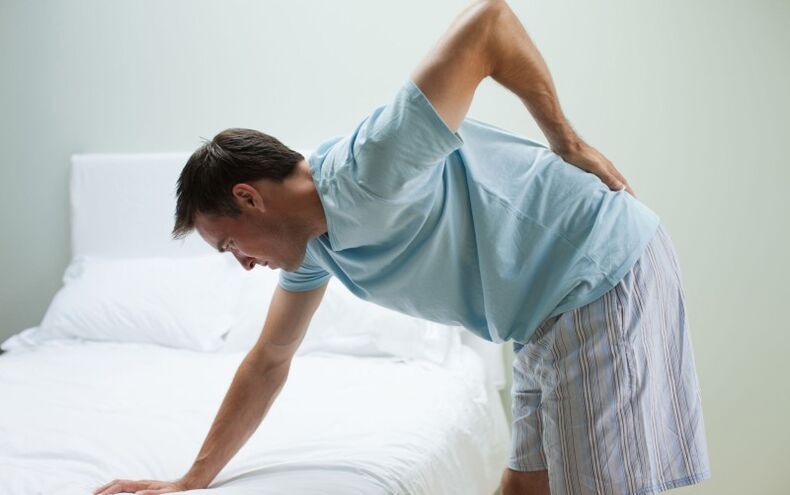In clinical practice, back pain is a fairly common syndrome. It affects the lumbar spine while the patient experiences "girdle pain". Thus, degenerative, musculoskeletal and dystrophic pathologies are manifested in the form of osteochondrosis or spondyloarthrosis.
Lower back pain - causes and symptoms
In medicine, the following causes of low back pain are traditionally distinguished:
- Infectious and inflammatory processes in the spine;
- Muscle spasms or pinched nerves;
- The formation of an intervertebral hernia;
- Spinal cord or spinal metastases;
- Scoliosis, lordosis, kyphosis;
- Circulatory disorders (with stroke, paralysis);
- Pathology of the gastrointestinal tract (atypical manifestation of appendicitis, obstruction of the biliary tract and intestines);
- Diseases of the kidneys, reproductive organs;
- In some cases, women may experience lumbar discomfort during late pregnancy.
Lower back pain can be acute or persistent (chronic). You can also "wander"; H. arise in another organ but give way to the lower back.

Acute pain occurs suddenly, has a piercing character, can impede movement and give way in the lower extremities and hips. The patient has a forced posture and limited mobility.
Acute pain is diagnosed when:
- stretching the long muscles of the back;
- Rupture of the spine and emergence of the intervertebral discs;
- Facet syndrome (clamping of the nerve root without displacement of the intervertebral discs);
- epedural abscess (immediate hospitalization of the patient required as there is a high risk of spinal cord compression);
- dystrophic abnormalities of the hip joint.
Chronic low back pain is characterized by loss of sensitivity, "lumbago" in the gluteal muscles, weakness of the lower extremities, and the formation of bone outgrowths.
The patient may experience postural disorders, intermittent claudication, deformities of the feet.
Chronic back pain occurs when:
- Osteochondrosis;
- ankylosing spondylarthrosis;
- metastatic and intradural tumors.
Diagnosing and treating back pain
The real cause of back pain can be diagnosed using CT (computed tomography), MRI (magnetic resonance imaging), X-ray, or ultrasound of the internal organs. The first two methods provide a comprehensive assessment of the condition of bones and soft tissues, an X-ray shows the integrity of the bones and the presence of neoplasms, and an ultrasound scan indicates diseases of organs and their systems.
The therapeutic course is prescribed only by the attending physician, depending on the diagnosis, it can include: taking analgesics, hormonal drugs, physiotherapy procedures or manual therapy, exercise therapy. If the pain is caused by a displacement of the intervertebral discs or develops against a background of osteochondrosis, it is effective to wear a rigid restraint corset. It significantly relieves the lumbosacral region and prevents muscle overload and the formation of spasms. Blockages - special injections into the intervertebral joints - have a good therapeutic effect. They relieve pain and relax the muscles.
In severe cases, surgery may be required. It is very important not to self-medicate, but to get qualified medical help in a timely manner.
During the rehabilitation period, you need to regularly do physical therapy exercises, undergo massage and physical therapy. This will help relieve muscle tension, improve blood circulation, and relieve tension.
General recommendations for pain in the lower back and lower back:
- Note bed rest. In this case, the bed should have a hard, flat surface. Strictly exclude soft down mattresses.
- wear a supportive bandage. It is especially important for pregnant women in their third trimester.
- Painkillers are allowed.
- Rub your back with ointments with warming and anti-inflammatory components. In no case should you undercool it, it is best to wear a woolen scarf or a warm belt if the pain worsens.
Back pain during pregnancy
If we talk about lower back pain during pregnancy, it is associated with a change in the center of gravity of the woman's body due to the development and growth of the fetus. Hormonal changes (excessive relaxin production) also slacken the hip-sacral joints, which disturbs the balance. An enlarged abdomen and excessive curvature of the spine increase the pressure on the lower back. Muscles are constantly being overloaded, which becomes the main cause of pain.
The risk group includes girls who, before pregnancy, had problems with hip muscle development, postural disorders, osteochondrosis, and neurological disorders of the spine. Painful sensations appear no earlier than the second trimester, and this happens around the fifth or sixth month. It can be alleviated by strengthening the muscles with a special exercise set. And the sooner you start exercising your back muscles, the easier it is to endure a healthy child.





































